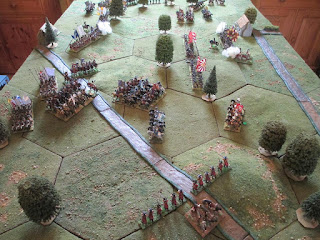My latest attempt at a 17th Century battle is Oldendorf, 1633: a Thirty Years' War engagement between Catholic and Protestant armies, but played with French (as the Catholics) and Allied (as the Protestants) armies from the 1670s. I played it solo and it resulted in an enjoyable game lasting twelve turns. The Allies won, but mainly because of the number of French units they destroyed, rather than the successful completion of objectives. Here are some photographs with comments where relevant. Figures are almost all North Star 28mm metal from their Sun King 1672 range (ex-Copplestone Castings), with some Warfare Miniatures generals and cannon. For the scenario rules, see my 17th Century Wargame Scenarios section.
The battlefield laid out ready to begin; French on the left, Allies on the right.
The Allied left wing and centre.
The Dutch Marwitz Dragoon Regiment.
The Spanish Alcantara Light Horse Regiment with
the Dutch Shellaert Light Horse Regiment in support.
The Allied centre, Anhalt-Bernburg Foot Regiment (Hesse-Kassel), Aylva Foot Regiment and Beaumont Foot Regiment (both Dutch), along with artillery and a squadron of the Ginkel Light Horse Regiment (Dutch).
The Allied right wing: Kurland Light Horse Regiment (Dutch), Erbprinz Dragoon Regiment (Hesse-Kassel) and a squadron of Nassau-Friesland Light Horse Regiment in support.
The French left wing and centre.
The French left wing: Fusiliers du Roi Foot Regiment with Mélac Light Horse Regiment, then Royal Cravattes Light Horse Regiment, and finally Asfeld Dragoon Regiment at the front.
The French centre: Cuirassiers du Roi Light Horse Regiment and Normandie Foot Regiment to the left, Grancey and Douglas (Scots) Foot Regiments to the right, with artillery to the front.
The French right wing: Dauphin Light Horse Regiment and La Fere Foot Regiment.
The French centre.
Asfeld Dragoon Regiment.
The battle starts, this shows the end of Turn One.
The French right wing advances.
The Allied left wing advances.
The Erbprinz Dragoon Regiment deploys for dismounted action.
The Allied right wing advances.
The French left wing advances.
The French Normandie Foot Regiment, one of the "Vieux Corps" - the six senior regiments of the line in the French Army.
The Cuirassiers du Roi Light Horse Regiment - the only cavalry regiment in the French army under Louis XIV to wear cuirasses. All cavalry officers were meant to wear a cuirass as well, but this seems to have been a rule rarely followed.
The French Douglas Foot Regiment. This was an old Scottish unit in the service of France. It eventually returned to England in 1679 and became the 1st Foot, i.e. the Royal Scots. I have not found any evidence for its flags in the 1670s, so I did a cross of St. Andrew on a blue field for the regimental colour and a cross of St. Andrew on a white field, paralleling the tradition in French units at that time.
The French artillery - I classify guns as Light, Medium, Heavy and Siege in my rules,
this is a Heavy Gun.
An Allied Medium Gun battery. There were no official uniforms for artillerymen at this time and guns were painted according to taste rather than regulations.
The French Grancey Foot Regiment moving forward in column, a formation used only for manoeuvre at this time, not combat.
The Anhalt-Bernburg Foot Regiment, a unit from Hesse-Kassel.
A squadron of the Dutch Nassau-Friesland Light Horse Regiment.
The French Fusiliers du Roi Foot Regiment; other than the Gardes françaises, this was the only unit armed with flintlock muskets during the 1670s.





























































No comments:
Post a Comment